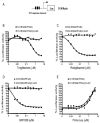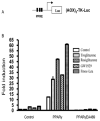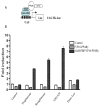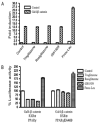Repression of beta-catenin signaling by PPAR gamma ligands
- PMID: 20303941
- PMCID: PMC2866743
- DOI: 10.1016/j.ejphar.2010.03.010
Repression of beta-catenin signaling by PPAR gamma ligands
Abstract
Aberrant activation of the Wnt/beta-catenin signaling pathway plays a crucial role in oncogenesis of various human malignancies. It has been demonstrated that there is a direct interaction between beta-catenin and PPAR gamma. Here we examined the effects of fifteen reported PPAR ligands in a reporter gene assay that is dependent on beta-catenin activation of TCF/LEF transcription factors; only the thiazolidinedione PPAR gamma agonists troglitazone, rosiglitazone and pioglitazone, and a non-thiazolidinedione PPAR gamma activator GW1929 inhibited beta-catenin-induced transcription in a PPAR gamma dependent fashion. The results from mammalian one-hybrid experiments showed that functional PPAR gamma was necessary for ligand-dependent inhibition of beta-catenin transactivation. However, a PPAR gamma activator Fmoc-Leu could not repress beta-catenin-mediated signaling and its transactivation activity. These results indicate that activation of PPAR gamma is necessary, but not sufficient, for the beta-catenin antagonistic activity of a PPAR gamma agonist, and that the inhibitory compounds interfere directly with beta-catenin transactivation activity.
(c) 2010 Elsevier B.V. All rights reserved.
Figures




Similar articles
-
Differential effects of peroxisome proliferator activated receptor-gamma (PPAR gamma) ligands in proximal tubular cells: thiazolidinediones are partial PPAR gamma agonists.Kidney Int. 2004 Jun;65(6):2081-90. doi: 10.1111/j.1523-1755.2004.00624.x. Kidney Int. 2004. PMID: 15149321
-
Peroxisome proliferator-activated receptor gamma (PPARgamma) suppresses colonic epithelial cell turnover and colon carcinogenesis through inhibition of the beta-catenin/T cell factor (TCF) pathway.J Pharmacol Sci. 2008 Apr;106(4):627-38. doi: 10.1254/jphs.fp0071766. Epub 2008 Apr 5. J Pharmacol Sci. 2008. PMID: 18391483
-
Peroxisome proliferator-activated receptor-gamma ligands inhibit TGF-beta 1-induced fibronectin expression in glomerular mesangial cells.Diabetes. 2004 Jan;53(1):200-8. doi: 10.2337/diabetes.53.1.200. Diabetes. 2004. PMID: 14693716
-
Interaction of nuclear receptors with the Wnt/beta-catenin/Tcf signaling axis: Wnt you like to know?Endocr Rev. 2005 Dec;26(7):898-915. doi: 10.1210/er.2003-0034. Epub 2005 Aug 26. Endocr Rev. 2005. PMID: 16126938 Review.
-
Hypothesis of Opposite Interplay Between the Canonical WNT/beta-catenin Pathway and PPAR Gamma in Primary Central Nervous System Lymphomas.Curr Issues Mol Biol. 2019;31:1-20. doi: 10.21775/cimb.031.001. Epub 2019 Jan 16. Curr Issues Mol Biol. 2019. PMID: 30647194 Review.
Cited by
-
Multiple Targets of the Canonical WNT/β-Catenin Signaling in Cancers.Front Oncol. 2019 Nov 18;9:1248. doi: 10.3389/fonc.2019.01248. eCollection 2019. Front Oncol. 2019. PMID: 31803621 Free PMC article. Review.
-
Turkish coffee has an antitumor effect on breast cancer cells in vitro and in vivo.Nutr Metab (Lond). 2024 Sep 13;21(1):73. doi: 10.1186/s12986-024-00846-4. Nutr Metab (Lond). 2024. PMID: 39272080 Free PMC article.
-
Bronchopulmonary Dysplasia: Crosstalk Between PPARγ, WNT/β-Catenin and TGF-β Pathways; The Potential Therapeutic Role of PPARγ Agonists.Front Pediatr. 2019 May 3;7:176. doi: 10.3389/fped.2019.00176. eCollection 2019. Front Pediatr. 2019. PMID: 31131268 Free PMC article. Review.
-
Molecular mechanisms of mesenchymal stem cell differentiation towards osteoblasts.World J Stem Cells. 2013 Oct 26;5(4):136-48. doi: 10.4252/wjsc.v5.i4.136. World J Stem Cells. 2013. PMID: 24179602 Free PMC article. Review.
-
Regulation of adipocyte differentiation and metabolism by lansoprazole.Life Sci. 2019 Dec 15;239:116897. doi: 10.1016/j.lfs.2019.116897. Epub 2019 Oct 20. Life Sci. 2019. PMID: 31644894 Free PMC article.
References
-
- Clevers H. Wnt/beta-catenin signaling in development and disease. Cell. 2006;127:469–480. - PubMed
-
- Crawford HC, Fingleton BM, Rudolph-Owen LA, Goss KJ, Rubinfeld B, Polakis P, Matrisian LM. The metalloproteinase matrilysin is a target of beta-catenin transactivation in intestinal tumors. Oncogene. 1999;18:2883–2891. - PubMed
-
- Debril MB, Renaud JP, Fajas L, Auwerx J. The pleiotropic functions of peroxisome proliferator-activated receptor gamma. Journal of molecular medicine (Berlin, Germany) 2001;79:30–47. - PubMed
-
- Forman BM, Tontonoz P, Chen J, Brun RP, Spiegelman BM, Evans RM. 15-Deoxy-delta 12, 14-prostaglandin J2 is a ligand for the adipocyte determination factor PPAR gamma. Cell. 1995;83:803–812. - PubMed
Publication types
MeSH terms
Substances
Grants and funding
LinkOut - more resources
Full Text Sources

